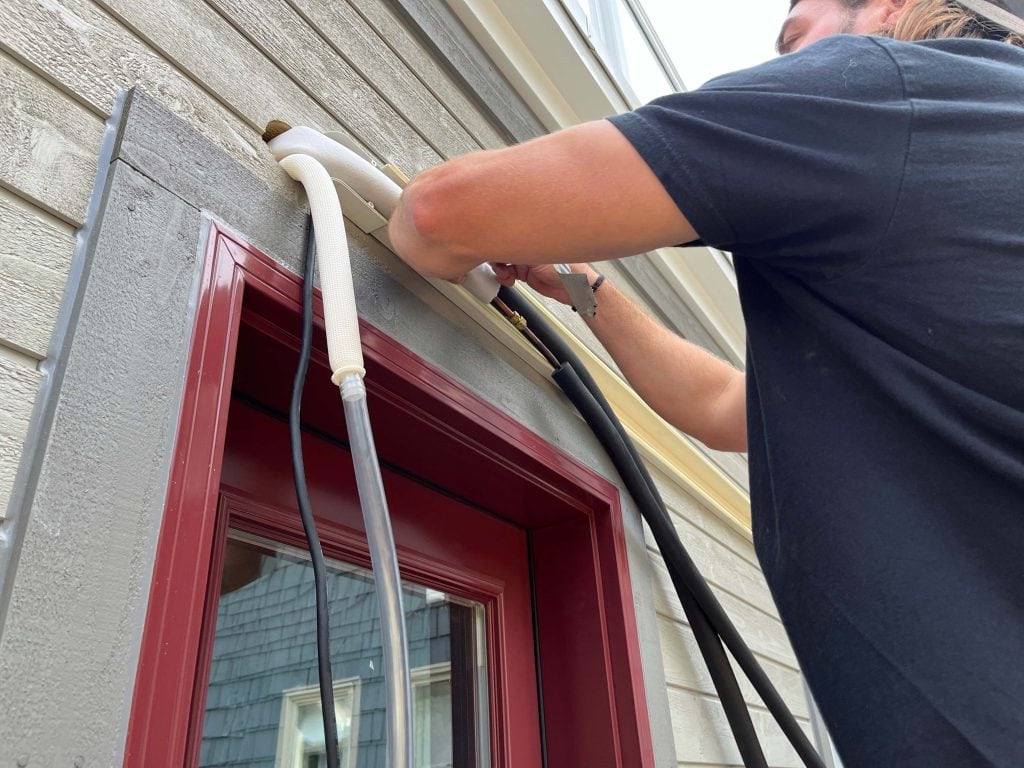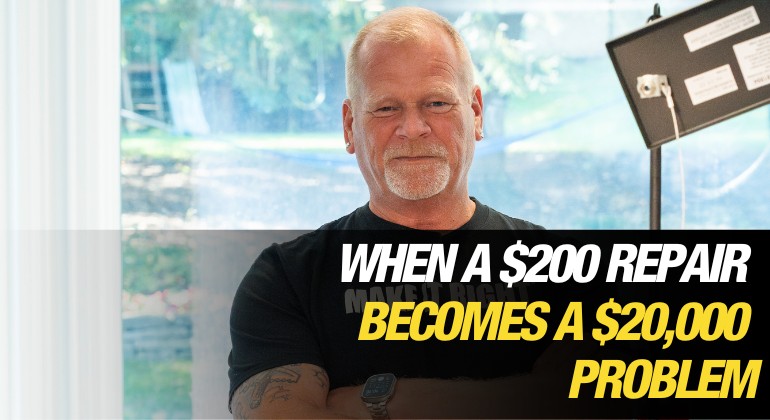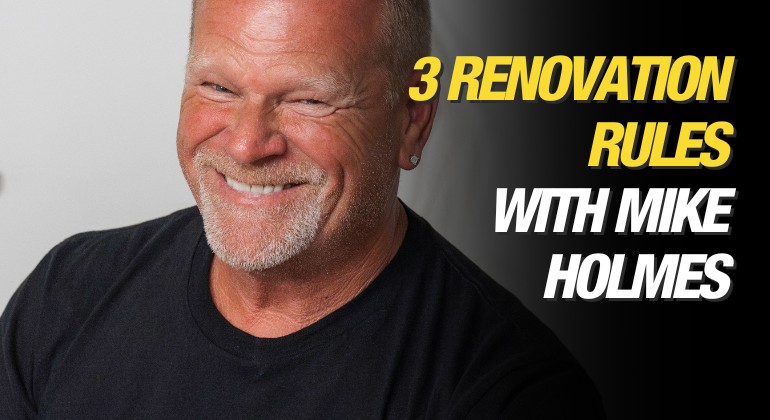When it comes to homes, water is enemy number one, and these 3 exterior home maintenance tasks will help prevent water damage. Water damage is one of the most costly...
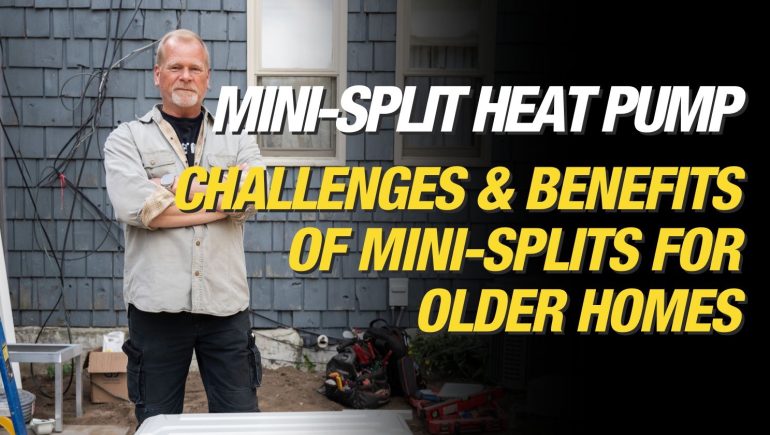
The Ultimate Guide to Mini-Split Heat Pumps for Old Homes: Efficiency, Comfort, and Savings
By Mike Holmes
Mike’s Advice / Home Renovation
Tuesday, October 1st, 2024 @ 4:14pm
Challenges & Benefits of Mini-Split Heat Pumps for Older Homes
I’ve been talking about heat pumps and mini-splits (a version of a heat pump) for a while now, and I believe they are a great heating and cooling option for your home. By this I mean, they can be a great option for both new homes and older homes.
Older homes tend to be draftier than new homes. Often the windows need replacing, and insulation can be minimal, leading to issues with keeping a consistent and comfortable temperature within the home.
If you have watched my recent shows, you may have seen mini-split heat pumps installed. These are an excellent idea for heating or cooling small spaces. However, there are a few potential issues to consider and address before installing this type of system.
Heating and Cooling Challenges in Older Homes
Older homes often struggle with:
- Drafty interiors
- Outdated windows
- Insufficient insulation
- Inconsistent indoor temperatures
These factors can make it difficult to maintain a comfortable living space year-round. However, there’s a modern solution that can address these issues: the mini-split heat pump system.
Understanding Mini-Split Heat Pumps
Before talking about the benefits and considerations, let’s first talk about what a mini-split heat pump is.
A mini-split heat pump is a highly efficient heating and cooling system that consists of an outdoor unit connected to one or more indoor air-handling units. These systems use refrigerant to transfer heat from the outdoors to the indoors (for heating) or vice versa (for cooling).
READ MORE
How Does A Mini-Split Heat Pump Work?
Mini-Splits vs. Traditional Air Conditioning in Older Homes
Adding a mini-split heat pump for air conditioning in an older or century home is an excellent idea. Installing mini-splits is less costly and more invasive than installing central system ducting.
However, it’s important to note that older homes have higher rates of air penetration and often little to no insulation, making mini-split heat pump sizing more complex than in newer construction. Work closely with your HVAC contractor to ensure you make the right choice for your home and needs.
READ MORE
Benefits of Installing Mini-Split Heat Pumps in Older Homes
Older homes come with their own set of charm, but also unique challenges when it comes to heating and cooling. Luckily, mini-split heat pumps provide a modern solution that doesn’t require costly renovations or extensive ductwork.
Here are the advantages of a mini-split heat pump:
- No ductwork is needed. Heating and cooling are not limited to areas with ductwork
- Zoning control. One outdoor unit can have multiple indoor units. If you have a room that doesn’t get proper heating or cooling, a mini-split can provide that for that “zone”.
- Convert more areas into liveable spaces. Adding a mini-split to an addition or a renovation is easy.
- Personalized temperature control. You can control the temperature of different indoor units separately. Very useful if you want your bedroom to be cooler but your basement to be warmer.
- Better indoor air quality. Some ductless mini-split systems have a multi-stage filtration system that will refresh and clean the circulating air by reducing potential allergens such as dust or pollen, odours, bacteria, and viruses.
Other benefits of installing a mini-split in an older home include:
- Increased efficiency levels. Mini-splits are known for their energy efficiency, often outperforming traditional systems due to their ability to transfer heat instead of generating it.
- Reduced carbon footprint. Because mini-splits move heat rather than create it, they consume less energy, which reduces overall emissions and environmental impact.
- Heating and cooling in one system. Mini-splits can provide both heating and cooling, eliminating the need for separate systems and simplifying your home’s climate control.
- No gas line is required. If your previous heating system relied on gas, mini-splits remove that requirement, although you can still keep your gas system as an auxiliary heat source if desired.
Key Considerations Before Installing A Mini-Split Heat Pump
Assess Your Home’s Insulation and Air Sealing
An older house with inadequate insulation can drastically reduce the efficiency of a heat pump. Inadequate insulation will also make your air source heat pump work harder to heat and cool your interior.
To maximize your mini-split heat pump’s performance, make sure you first:
- Upgrade your insulation, particularly in the attic and basement
- Seal air leaks around windows, doors, and other openings
- Consider a professional energy audit to identify areas for improvement
A well-insulated house not only enhances the performance of your mini-split system but also reduces overall energy consumption in both summer and winter.
RELATED
Can Mini-Split Heat Pumps Work In Cold Climates?
One common question I get asked a lot is, how efficient are mini-split heat pumps in cold climates? The good news is that heat pump technology has significantly improved over the years. Modern mini-split systems can now handle keeping your home warm even during abnormally low temperatures. However, in some extreme climate zones, a backup heating system is still recommended for maximum comfort.
Cost Considerations: Initial Investment vs. Long-Term Savings
When installing a heat pump, one should take the initial cost into account, especially if the house is older and needs further care or adjustments to support the heat pump. To determine whether a heat pump is the best solution for your older home, you should also consider the average cost of electricity in your area.
Remember, this is a long-term investment. While the upfront costs may be higher than traditional HVAC systems, mini-splits usually provide significant energy savings over time. They can even help reduce your utility bills.
As I always say, it’s important to consult with a licensed HVAC provider in your area before making a decision. They can provide a detailed cost analysis and help you understand the potential return on investment for your specific situation.
RELATED
Take Advantage of Rebate Programs and Grants
In 2024, one of the primary Ontario energy rebate programs remains the Home Efficiency Rebate Plus (HER+) program. Through HER+, homeowners can potentially save up to $7,800 on their heat pump installations.
To find out what rebate programs are offered in your area:
- Contact your local HVAC technician
- Reach out to your local government office
- Check with utility companies for additional incentives
- Research federal and state/provincial energy efficiency programs
Other Considerations When Looking to Install a Mini-Split Heat Pump In An Older Home
While mini-split heat pumps offer many advantages, there are a few things to keep in mind before installing them. Depending on the size and layout of your home, you may need multiple indoor units to achieve complete coverage, especially if you’re heating or cooling several rooms.
Additionally, the indoor units are typically mounted high on walls, which can affect the aesthetic of your space. However, these units are designed to be sleek and often blend into the background over time, making them less noticeable in daily life
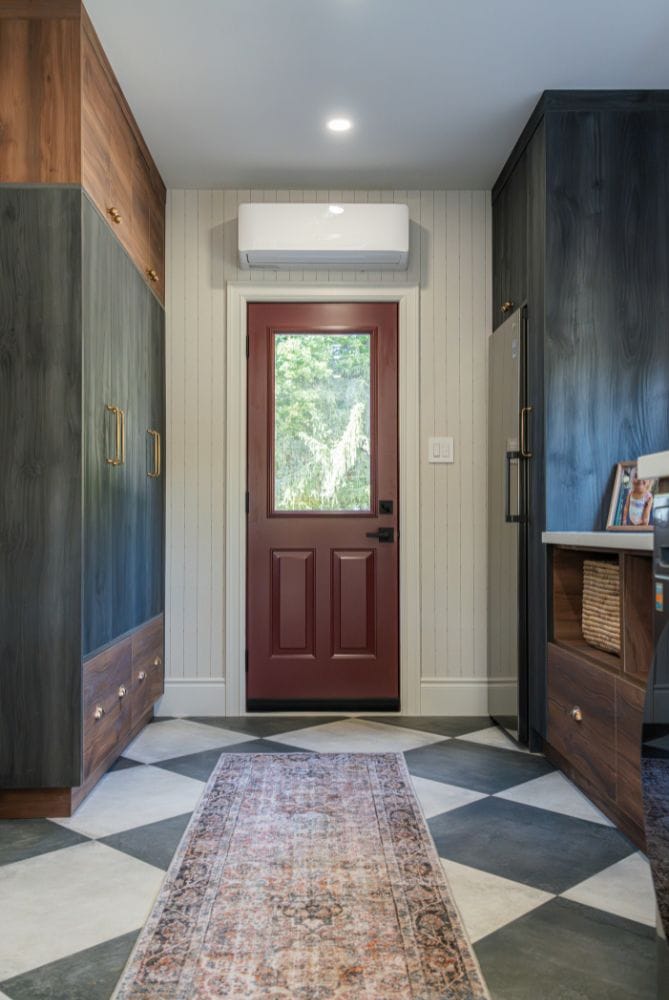
Mini-split heat pump indoor units are typically placed high above on the wall and after a while, you’ll barely notice it’s there.
When planning to install a mini-split heat pump in an older home, there are a few important factors to take into account:
- Consider the outdoor space location – needs lots of room for ventilation, access, and preferably a shaded area away from direct sunlight – however the outside unit needs to be relatively close to the indoor unit due to the refrigerant lines
- Noise considerations – the fan and compressor make noise – try to choose a location that will have minimal effect on your day-to-day life
- Always check with local regulations – your HVAC professional should be able to assist through this whole process
Inspecting and Upgrading Your Current HVAC System
Just like your insulation you also need to ensure your existing ductwork is inspected for cracks, damages and general deterioration.
It’s crucial to understand that leaky or poorly insulated ducts can significantly hamper the effectiveness of a heat pump system. This can lead to increased electricity consumption and an uncomfortable interior. Similar to the insulation of your house, your ductwork system must also be adequately insulated to ensure the air source heat pump operates correctly and efficiently.
If your older home has an existing ducted system:
- Have a professional inspect the ductwork
- Repair or replace damaged sections
- Ensure proper insulation of all ducts
- Consider duct sealing to improve efficiency
READ MORE
Ductless Options for Homes Without Existing Ductwork
Ductless mini-split systems provide an option if ducting changes are not practical in old houses. However, these systems are installed as separate units in different areas of your home.
Just keep in mind that while this offers you more customization for your indoor comfort compared to central heating, having several air-source heat pump units can take up more space. However, the unit is typically placed high above on the wall and after a while, you’ll barely notice it’s there.
READ MORE
Mini-Split Heat Pumps: 6 Reasons to Go Ductless on Your Next Installation
Can Air Source Heat Pumps Use Existing Radiators?
Yes, heat pumps can use existing radiators with some modifications for optimal performance. Given that air-source heat pumps operate at lower temperatures than traditional boilers, it’s crucial to pair the heat pump’s output with larger or specially designed low-temperature radiators.
To ensure a smooth integration with your current radiator heater, seek advice from an HVAC specialist. They will evaluate your old radiators, recommend changes, and ensure everything functions properly.
With these modifications, older homes with radiators still in place can benefit from installing a heat pump.
Choosing the Right System and Installer
When selecting an installer, consider:
- Their experience with older homes
- Certifications and licenses
- Customer reviews and testimonials
- Warranty and after-installation support
Maintaining Your Mini-Split Heat Pump
Like any HVAC system, heat pumps work year-round to heat and cool your house. Therefore, HVAC maintenance with a professional HVAC technician should occur at least twice a year. Heat pumps should be serviced in the spring and fall. This will ensure your heat pumps are working correctly and at optimal performance levels throughout each season.
In addition to professional maintenance, homeowners should:
- Change air filters regularly (typically every 1-3 months)
- Keep outdoor units unobstructed and clear of debris
- Clean indoor unit vents and grilles
READ MORE
The Ultimate Guide to Heat Pump and Furnace Maintenance: Tips to Keep Your System Running Smoothly
Mini-split heat pumps can function perfectly in older homes as long as they are installed and designed appropriately to supply adequate heat. Installing a heat pump in an older house shouldn’t be discouraged – in fact, it can be a game-changer for comfort and energy efficiency.
Remember, every home is unique, and what works for one may not be ideal for another. Always consult with qualified professionals to determine the best heating and cooling solution for your specific needs and circumstances.
READ NEXT
19 Biggest Home Renovation Mistakes to Avoid

